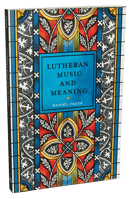Music has meaning. More than a series of notes, more than associated verbal texts, more than personal entertainment—music has meaning. In Lutheran Music and Meaning, author Daniel Zager demonstrates how music signals and conveys meaning. With suggested listening examples, chapters discuss the means that the great Lutheran composers used to convey meaning and in what ways liturgy, Church Year, and lectionary provide integrated contexts for meaning. Written specifically for the singer and listener, this book assists the curious in learning more about Lutheran music, its function, and its meaning.
A Quintessential Question on Music
"What—if anything—does Lutheran music mean? In fact, can music take on meaning? If so, how?" Daniel Zager poses these questions, among others, in the introduction to his book Lutheran Music and Meaning. In many ways, the question "What does this mean?" is the quintessential Lutheran question. Martin Luther posed this question in his Small Catechism as a way of getting to the foundational answers of the Christian faith.
When one arrives at the topic of the Church's music, the same question is relevant. How do church musicians, pastors, and laypeople determine what the Church's music ought to sound like? Who gets to determine the meaning of that music?
"I keep hearing that music is neutral—that only the text is what speaks theologically," Zager said in an interview. "But the text has to be complemented by music, because music always has meaning."
Music Complementing Text
The question of how exactly music complements text to produce meaning is a complicated one, with many variables and layers. Zager points out in his book that in the Lutheran chorale tradition, over the years the Church has come to associate certain melodies with texts to the point that they're inseparable. But at the same time, other hymn texts can be and have been sung to multiple melodies, from the immediate post-Reformation era to now.
"When we go to Lutheran church music, my thesis is that it's always connected to a text," Zager said. "Whether that text is sung or states, or whether a familiar melody signals a text, in that associative way music takes on a theological meaning."
The theological meaning that accompanies church music is significant, of course. Especially in the Lutheran tradition, music is held in the highest regard and shapes and guides the liturgy of the daily offices and the Divine Service. Hymn texts and tunes are instrumental in the catechesis of children and they develop and nurture the faith of the Christian throughout the earthly life. They are a source of great comfort in times of suffering, and they faithfully proclaim the good news of salvation through Jesus Christ.
"Pastors go through great lengths to plan services and musicians try to choose music and hymns carefully to make sure it's all part of a cohesive whole, but sometimes what we don't do is give our parishioners a notion that that's true," Zager said. "I wanted to write in such a way that our congregants who are curious might understand music in the service better. It suggests to the interested listener that music does play a role in the proclamation of the gospel."
Embracing Musical Heritage and Theological Meaning
The musical heritage of the Lutheran church is overflowing with riches, from Luther to Praetorius to Bach, and even to the present day. In the book, Zager provides some of the context and pedagogy associated with these musical giants, and how the Church today might consider and utilize what they've left.
Throughout the book, Zager discusses certain chorales, organ preludes, and other sacred music compositions as prototypes for uncovering theological meaning. He also includes suggestions for the reader to listen to in order to hear some of that meaning and technique that composers integrate with a particular text. Take a listen in this playlist below.
Though the book is written primarily for the parishioner interested in learning more about meaning in church music, it also serves brilliantly to calibrate the church musician's focus.
"I hope church musicians immerse themselves in the Church Year, lectionary, and hymnal," Zager said. "There's such richness when we combine those three ingredients so that when we do pay attention to the yearly arc of the Church Year, we walk with Jesus through the seasons and see how the readings complement one another and draw meaning from that. Then as musicians, we can go into the hymnal and find hymns that underscore and reinforce those theological realities. In a sense, we're being exegetes."
Whether you're a parishioner, church choir member, organist, cantor, or pastor, Lutheran Music and Meaning is full of history, theology, and insight into what makes for good church music—music that has meaning. When that is attained, and text and melody unite to create theological meaning, the gospel is rightly proclaimed, and the story of Christ come to die for sinners sounds forth in glorious acclamation.

Discover more from author Daniel Zager on this topic in his book, Lutheran Music and Meaning.
























